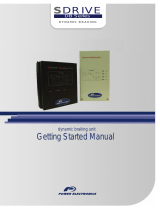
Operational manual for dynamic braking unit
-1-
Content
1 Safety Precautions .............................................................................................................. 1
1.1 Safety definition ........................................................................................................ 1
1.2 Warning symbols ...................................................................................................... 1
1.3 Safety guidelines ...................................................................................................... 1
2 Inspection ............................................................................................................................ 4
2.1 Unpacking inspection ............................................................................................... 4
2.2 Environment ............................................................................................................. 4
2.3 Installation confirmation ............................................................................................ 5
3 Installation Guidelines .......................................................................................................... 6
3.1 Installation environment ............................................................................................ 6
3.2 Installation direction .................................................................................................. 7
3.3 Installation mode ...................................................................................................... 8
3.4 External dimensions ................................................................................................. 8
4 Product name, model definition and usage ........................................................................ 10
5 Installation of the dynamic braking unit and parameters setting .......................................... 11
5.1 Wiring diagram ....................................................................................................... 11
5.2 Terminals of the main circuit ................................................................................... 11
5.3 Main control terminal of the braking unit ................................................................. 12
5.4 Adjustment ............................................................................................................. 12
5.5 Voltage selection setting ......................................................................................... 12
6 Parallel running.................................................................................................................. 14
7 Fault analysis and the solution ........................................................................................... 15
8 Selection ........................................................................................................................... 16
8.1 Guidelines of braking voltage selection ................................................................... 16
8.2 Calculation of the braking resistor and the braking current ...................................... 16
8.3 Calculation and selection of the braking resistor ..................................................... 16
8.4 Usage standard and selection reference of the input voltage degree for adaptation
DBU (220V) .................................................................................................................. 17
8.5 Usage standard and selection reference of the input voltage degree for adaptation
DBU (380V) .................................................................................................................. 17
8.6 Usage standard and selection reference of the input voltage degree for adaptation
DBU (660V) .................................................................................................................. 18
8.7 Selection of the braking resistors: ........................................................................... 19
9 Maintenance and hardware diagnostics ............................................................................. 21
9.1 Maintenance intervals ............................................................................................. 21
9.2 Cooling fan ............................................................................................................. 24
9.3 Power cable ........................................................................................................... 24




















